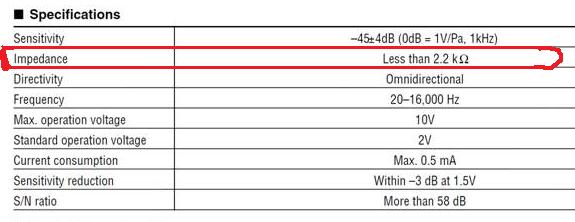What is Microphone Impedance?

Microphone impedance is the amount of opposition that a microphone has to AC signals.
Every microphone comes with an impedance rating. What is the significance of this rating? What is a good rating? As a general rule, the lower the impedance rating, the better. Why is this so? This will be explained now.
When a person talks into a microphone, the speech that is spoken are AC voltage signals. When we talk, it is AC voltage signals that we speak. These signals are, in turn, picked up by the microphone and converted into equivalent electrical signals. Most of the times, the microphone is hooked up in series to an amplifier so that the amplifier can increase the strength of the signal, since the microphone signals alone are not powerful enough to drive speakers. So the microphone is connected in series with an amplifier.
Now remember that when devices are hooked up in series, a voltage divider circuit is formed. Voltage is divided, or dropped, across the devices depending on the impedance of the devices. More voltage is dropped across the device with the higher impedance and less voltage is dropped across the device with the lower impedance. With the circuit that we have with a microphone in series with an amplifer, we want the maximum amount of voltage possible transferred to the op amp so that it can get all of the signal from the microphone, amplify it, and bring it to the next part of the circuit, which may be speakers to play out the sound. If most of the signal gets dropped across the microphone and not the amplifier, this is a waste, since it doesn't go on to get amplified and passed on as output. It is desired that most of the AC voltage signals get dropped across the amplifier so that it can receive the full signal and amplify it and drive it to the next part of the circuit. In order for the maximum voltage transfer to occur from the ac voltage signals to the op amp, the microphone should be the lowest impedance possible while the op amp should be the highest impedance possible. With this setup, most of the voltage drops across the amplifier.
Usually, impedance is not a critical factor in microphone circuit design because normally the amplifier that amplifies the signal output from the microphone has a very high input impedance of several megohms. So compared with the typical microphone that has an impedance of about 1-2KΩ, the amplifier gets the majority of the voltage signal dropped across it rather than the microphone. However, in the case where a microphone may have very high impedance of over several hundreds of thousands of ohms and the impedance of the amplifier may be low, choosing a microphone with the correct impedance may be crucial for proper signal recording.
Related Resources
What is Microphone Sensitivity?
What is a Directional Microphone?
What is Microphone Frequency?
What is a Microphone's Sensitivity Rating?